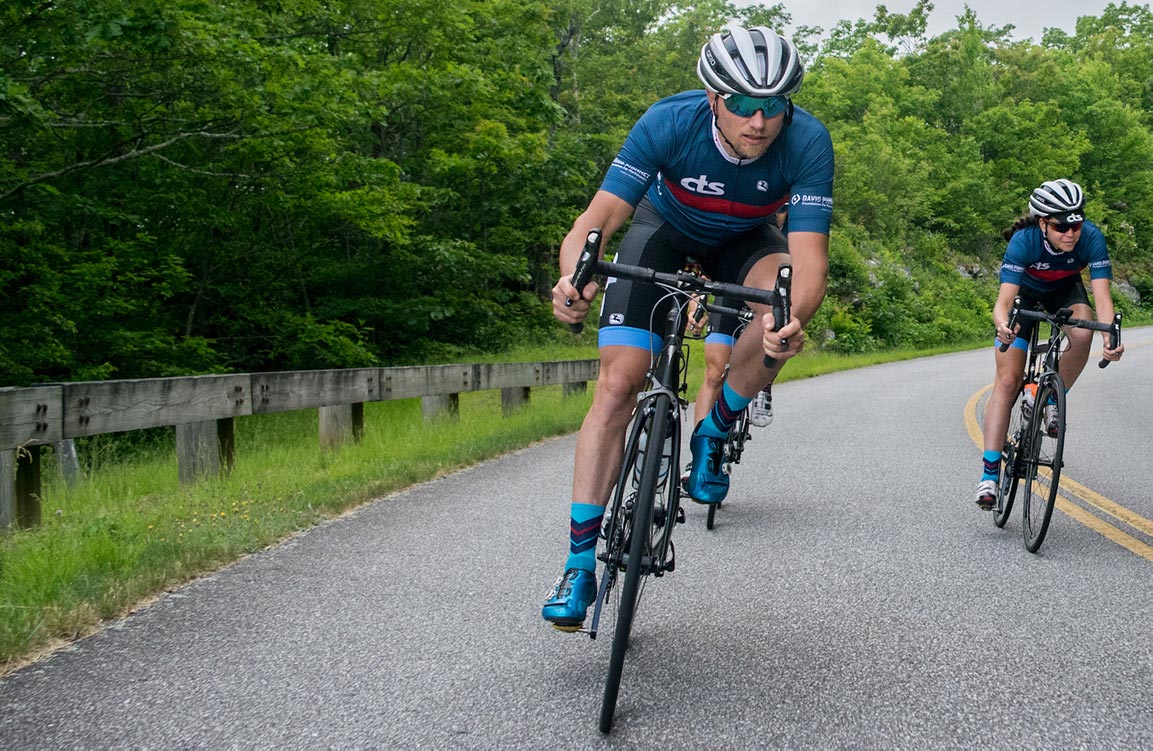
How to Improve Grip Strength for Faster and Safer Cycling
By Chris Carmichael,
Founder and Head Coach of CTS
I started noticing it about halfway down the Col de la Madeleine. In the group I was with, riders started shaking out their hands on the straightaways between switchbacks. Even with disk brakes, the effort of gripping the bars and using the brakes for such a long descent was leading to hand pain and grip fatigue. And it’s not just big road descents. I see the same thing in long gravel events and endurance mountain bike events. Grip strength doesn’t get a lot of attention in terms of cycling training, but especially as more masters cyclists dive into gravel racing, endurance mountain biking, and bucket-list road cycling trips, weak hands are becoming a bigger issue.
Grip Strength and Health
There’s a big difference between having a firm handshake and strong grip. Back when I was a younger man, living in a cabin up in Cheyenne Canon above Colorado Springs, I did a lot more work with my hands. I chopped and hauled wood, shoveled tons of snow and gravel, swung a hammer, etc. As I approach 60 years old, I live in town and do a lot less work with my hands, a fact that became evident recently after a small home repair project left my hands and forearms sore for days.
I am not alone. Across the population, grip strength tends to start dropping when people reach their mid 50s, about the same time that declines in whole-body muscle mass accelerate due to sarcopenia. This drop in grip strength can be exacerbated by sedentary lifestyles, passive careers (sitting behind a computer…), and chronic medical conditions like arthritis. For older adults, grip strength is also used a biomarker for overall health. A 2015 study of nearly 140,000 subjects between the ages of 35-70 years old, over a four year period, found that a 5% decrease in grip strength was associated with a 16% increased risk of all-cause mortality (Leong, et al). Similar studies have linked decreased grip strength to increased risk of mobility issues later in life. It’s not that a weaker grip means a weaker heart, but more that a weaker grip may be indicative of other lifestyle choices or of the consequences of other medical limitations.
Grip strength and Cycling
Getting back to cycling, grip strength is important for being able to hang on to the handlebars (particularly over rough terrain) and squeeze the brakes. And the bigger challenge is not how much force you can generate, but rather how resistant your hands and forearms are to fatigue. So, why does a strong grip make you faster? Because when your hands are tired you get more cautious, which means going slower. Of course, some problems with grip strength for cycling are less about strength and more related to bike fit, handling skills, and confidence. A death grip on the handlebars or riding the brakes all the way down a descent is going to wear out your hands and forearms no matter how strong they are.
There are many classifications of power and precision grips, but they are more broadly categorized as: Crush, Support, and Pinch. Crush grip is for squeezing something between your fingers and palm, like crushing an orange or wrapping your hand tightly around the handlebar. Support grip is your ability to hold things or hang from things, where you have to keep your fingers from extending, like carrying a suitcase or doing a pullup. And pinch grip is holding something between your fingertips and thumb, from lightweight things like a pencil to heavier items like a book or weight plate. All three are important during cycling, and you can develop them with the following exercises:
Bar Hang
Grasp a pull up bar, but instead of doing a complete pull up, just hang as long as you can. To make even better use of this time, I like to complete one or two pullups and then hang, or do a few scapular pullups. A bar hang is also a great way to relieve some pressure on your back if you’ve been standing for a long time. Rest 1-2 minutes between efforts and complete 5 hangs.
A more advanced version of this exercise is to hang while grasping a rope or towel that is hanging vertically. When hanging from a horizontal bar, you have to keep your fingers from extending, but to grasp a towel or rope hanging vertically you have to squeeze tightly so it doesn’t slip through your hand.
Farmer’s Walk/Carry
This is otherwise known as the “can you get all the grocery bags into the house in one trip” carry. Using two dumbbells or kettlebells, grasp the weights with your arms by your side and hold them there. Aim for 60-90 seconds at a time and complete 5 reps. You can just stand and hold, or add a core strength and stabilization challenge by walking as you hold the weights. A good starting point is 50% of your bodyweight (25% of your bodyweight in each hand), and then adjust up or down as needed. Remember to keep your shoulders engaged, rather than just letting the weights pull your arms down.
► Free Cycling Training Assessment Quiz
Take our free 2-minute quiz to discover how effective your training is and get recommendations for how you can improve.
Pinch Twists
If you’re in a gym you can use weight plates for this exercise. At home a large cookbook or heavy cutting board can do the trick. The key is that it’s a heavy object you can lift and hold with your fingertips. Start with the weight on the floor at your side. Grasp it in a pinch grip and lift it off the floor as you stand up. Raise the object until your arm is straight out in front of you and alternately supinate and pronate your wrist, rotating to palm up and palm down 10 times each. Switch hands and repeat. Complete the exercise five times with each hand.
Preserve your grip by loosening up
The exercises above are just a few options you can use to strengthen your grip, but to reduce hand and forearm fatigue on the bike it is also important to address how you are riding. On rough terrain, whether it is gravel racing, mountain biking, a cobbled sportive, or cyclocross racing, your goal should be to maintain a secure but light grip on the bars. A death grip on the bars will make the rough ride rougher, which will then make you want to grip even tighter. For a smoother ride, use a lighter grip on the bars and relax your elbows and shoulders so they can act like shock absorbers.
On long descents, the key is to let go of the brakes when you can, which means getting comfortable with picking up speed where it is safe to do so. Riding the brakes down a long descent is not only tough on your hands, it’s really hard on your brake pads and either your rims or disks. To allow either brake setup time to cool down, it is better to pick up speed and brake hard for a shorter time, than to maintain a slow speed by dragging the brakes for longer periods. Overheating with rim brakes can damage carbon rims or lead to tire blowouts, and overheating disk brake systems cause the brakes to fade.
► FREE Mini-Course: Learn How to Maximize Your Limited Training Time
Learn step-by-step how to overcome limited training time and get faster. Walk away with a personalized plan to increase your performance.
"*" indicates required fields


Comments 8
Pingback: The Handgrip Challenge - SMART BRAKE
Think the most common cause of sore hands/arms — especially when in the drops on descents — would be the saddle set too far forward. That places more weight on the hands. (Just 5 mm can make a huge difference.)
You could just go to your local climbing gym and pull on some plastic holds. Its way more fun:)
Yep, same, I break up core days with bouldering at the climbing gym. My grip strength and core isolation is way better. The secret is to not overreach like yoga. I’ve had a couple of pulleys until I figured out to know my current limits.
I’m not sure why anyone would be gripping their brakes on a descent from the Col de la Madeleine. The brakes just need to be applied to slow prior to a corner. No continuous use or extraordinary force. I’d suggest your cyclist develop some basic skills before heading to the mountains. I use Rim brakes on carbon wheels and there is no problem in the mountains. No need for a continuous or hard grip. Sit in the drops where you can maintain a hold on the bars with almost zero grip pressure.
Author
We work with cyclists of wide ranging abilities, and there are a lot of riders who struggle with big mountain descents, particularly technical descents on narrow roads with no guardrails. We have helped thousands of road, gravel, and mountain bike riders improve their confidence and skills for descending. There are always new riders who are learning what you may already know, as well as veteran riders who just don’t have much experience going downhill.
Seems like some good tips here. I am one of those cyclists who does grip brakes / handlebars excessively and suffer hand strain because of this. It’s because I only started cycling later in life , and am currently tackling my fear of descents ( having come off badly on a really steep descent last year ). I am trying to regain confidence and getting better but am not there yet. I am a good climber but what goes up must come down – so easy for the experienced cyclist to make such comments but I have to learn . So thank you for this article , super useful for people like me ( and so if it isn’t useful for some others don’t pass comment for those of us who do!!)
indeed! i’m also a new cyclist and have had quite an accident while going downhill, and got a bit traumatized. So now i’m also working on gaining my confidence back, but still got nasty sore hands, arms, and shoulder after a downhill ride. And this kind of article is really helpful for me too!